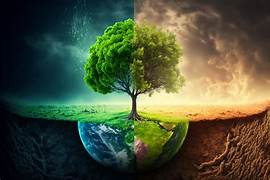Economic Inequality and Environmental Sustainability: Evaluating the Relationship
Economic inequality and environmental sustainability are two critical issues facing the world today, and while they are often addressed separately, there is an undeniable connection between the two. On one hand, economic inequality can exacerbate environmental degradation, and on the other, environmental degradation can deepen economic inequality. Understanding the interplay between these two issues is essential to creating sustainable solutions that promote both social and environmental well-being.
This article explores the relationship between economic inequality and environmental sustainability, analyzing how unequal distribution of wealth impacts environmental outcomes and how environmental challenges can perpetuate or deepen economic inequality. Furthermore, we will examine policies and strategies that can mitigate the negative effects of economic inequality on the environment and vice versa, while promoting a more sustainable and equitable future.
Understanding Economic Inequality
Economic inequality refers to the uneven distribution of wealth, income, and resources within a society. It is often measured using metrics such as the Gini coefficient, which quantifies income disparity, or the income share of the richest versus the poorest segments of the population. Economic inequality can manifest in various forms, such as unequal access to education, healthcare, and employment opportunities, as well as significant disparities in wealth accumulation.
The consequences of economic inequality are widespread. When wealth is concentrated in the hands of a few, it can lead to social and political instability, hinder economic mobility, and perpetuate poverty. High levels of inequality can also lead to underinvestment in essential public goods, such as infrastructure, education, and healthcare, further exacerbating disparities between different social groups.
Understanding Environmental Sustainability
Environmental sustainability refers to the responsible use and management of natural resources to ensure that the planet’s ecosystems can continue to support life for future generations. It involves reducing pollution, conserving biodiversity, managing natural resources efficiently, and addressing the causes of climate change. Sustainable development focuses on meeting the needs of the present without compromising the ability of future generations to meet their own needs.
Environmental sustainability is critical to ensuring the long-term health of the planet. Ecosystem degradation, loss of biodiversity, and climate change pose significant risks to human well-being and economic stability. In order to promote sustainability, efforts must be made to transition to renewable energy, reduce carbon emissions, protect natural habitats, and adopt sustainable consumption and production practices.
The Connection Between Economic Inequality and Environmental Sustainability
The relationship between economic inequality and environmental sustainability is complex and multifaceted. Economic inequality can contribute to environmental degradation, while environmental challenges can exacerbate inequality. Below, we explore how these two issues are interconnected.
1. The Consumption-Production Loop: High Consumption, High Impact
One of the most significant ways that economic inequality influences environmental sustainability is through the consumption patterns of the wealthy. Wealthier individuals and nations tend to consume a disproportionate share of natural resources and produce a larger share of carbon emissions. High-income individuals typically have larger homes, more vehicles, and greater access to luxury goods and services, all of which contribute to higher levels of resource consumption and waste production.
On a global scale, high-income countries are responsible for a large portion of global carbon emissions. According to data from the World Bank, the wealthiest countries—many of which are industrialized—emit far more carbon dioxide per capita than poorer nations. This consumption pattern exacerbates environmental degradation, contributing to climate change, deforestation, and resource depletion. Meanwhile, poorer communities often bear the brunt of the environmental damage caused by overconsumption, facing increased exposure to pollution, inadequate waste management, and limited access to clean water and air.
2. Environmental Degradation Deepens Poverty
Environmental degradation, such as deforestation, soil erosion, and climate change, disproportionately impacts the poor, further deepening economic inequality. Low-income communities often rely more directly on natural resources for their livelihoods, including agriculture, fishing, and forestry. When these resources are degraded due to environmental mismanagement or climate change, the livelihoods of poor communities are jeopardized, exacerbating poverty and inequality.
For example, climate change has led to more frequent and severe natural disasters, such as floods, droughts, and hurricanes, which disproportionately affect low-income populations. These communities often have fewer resources to recover from these events, leaving them in a cycle of poverty that is difficult to escape. Additionally, the displacement of populations due to environmental disasters can lead to overcrowding in urban areas, straining social services and infrastructure and creating additional economic challenges.
3. Unequal Access to Green Resources and Opportunities
Economic inequality also results in unequal access to green technologies and sustainable resources. Wealthier individuals and countries are better positioned to invest in renewable energy, energy-efficient technologies, and sustainable farming practices. In contrast, poorer communities may lack the financial resources to make the transition to more sustainable practices, such as installing solar panels or using energy-efficient appliances.
This disparity in access to green resources not only perpetuates economic inequality but also creates a vicious cycle where poorer communities continue to rely on environmentally harmful practices. For instance, communities with limited access to clean energy sources may rely on wood or coal for cooking and heating, which contributes to deforestation, air pollution, and other environmental harms. In this way, economic inequality impedes the adoption of environmentally friendly technologies and practices, further undermining sustainability efforts.
4. Global Inequality and Environmental Justice
At the global level, the relationship between economic inequality and environmental sustainability is also shaped by issues of environmental justice. Wealthier nations have historically been the largest contributors to environmental degradation, yet poorer nations—often those that have contributed the least to the problem—are the ones most affected by its consequences. This is particularly evident in the context of climate change, where developing countries are more vulnerable to the impacts of rising sea levels, extreme weather events, and resource scarcity.
The principle of environmental justice calls for fair treatment and meaningful involvement of all people in environmental decision-making processes. It advocates for addressing the disproportionate environmental burdens faced by marginalized communities, both within countries and globally. Achieving environmental sustainability requires addressing these inequities and ensuring that those who have historically been excluded from decision-making have a voice in shaping policies that affect their environment and livelihoods.
Policies and Strategies for Addressing the Link Between Economic Inequality and Environmental Sustainability
Addressing the link between economic inequality and environmental sustainability requires integrated policy solutions that tackle both issues simultaneously. Below are some strategies that can help mitigate the negative effects of economic inequality on the environment and promote a more sustainable and equitable future.
1. Transitioning to a Green Economy
A key strategy for addressing the intersection of inequality and sustainability is transitioning to a green economy—one that promotes low-carbon, resource-efficient, and socially inclusive growth. Governments can invest in green technologies, renewable energy, and sustainable agriculture, creating jobs and economic opportunities for low-income communities while reducing environmental harm.
For example, renewable energy projects such as solar and wind farms can provide clean energy while creating jobs in underserved communities. Additionally, policies that promote energy efficiency and the adoption of green technologies in low-income households can reduce both energy costs and environmental impact.
2. Promoting Sustainable and Inclusive Development
Policies should aim to promote sustainable and inclusive development that benefits all sectors of society. This includes reducing poverty, improving access to education and healthcare, and promoting social equity. A more equitable distribution of wealth and resources can create the foundation for greater environmental sustainability, as individuals and communities with better access to resources are more likely to adopt sustainable practices.
Sustainable development strategies should prioritize addressing the needs of marginalized communities, ensuring that they have access to clean energy, healthcare, and educational opportunities. By improving social safety nets and reducing economic inequality, governments can create more resilient societies that are better equipped to face environmental challenges.
3. Strengthening Environmental Justice Initiatives
Environmental justice initiatives aim to ensure that all communities, especially marginalized ones, are not disproportionately impacted by environmental hazards. This includes addressing the unequal distribution of pollution, waste, and toxic substances in poor neighborhoods, as well as promoting fair participation in environmental decision-making processes.
Governments and international organizations must work to ensure that environmental policies are equitable and inclusive, taking into account the needs and voices of the most vulnerable populations. Environmental justice also involves ensuring that the costs of environmental degradation are not unfairly borne by the poor and marginalized.
4. International Cooperation and Climate Finance
Global cooperation is essential in addressing the interconnections between economic inequality and environmental sustainability. Wealthier nations must support developing countries in their efforts to transition to sustainable economies by providing financial resources, technology, and expertise. Climate finance, which helps developing countries mitigate and adapt to the effects of climate change, is a key tool in promoting global sustainability and reducing inequality.
Conclusion
Economic inequality and environmental sustainability are deeply intertwined, and addressing one without considering the other can lead to incomplete solutions. Economic inequality exacerbates environmental degradation, while environmental harm often disproportionately affects the poor. To achieve a more sustainable and equitable future, it is essential to adopt policies that promote both social and environmental well-being. This includes transitioning to a green economy, promoting inclusive development, addressing environmental justice, and fostering international cooperation. By addressing the root causes of both inequality and environmental degradation, we can create a more just and sustainable world for future generations.


